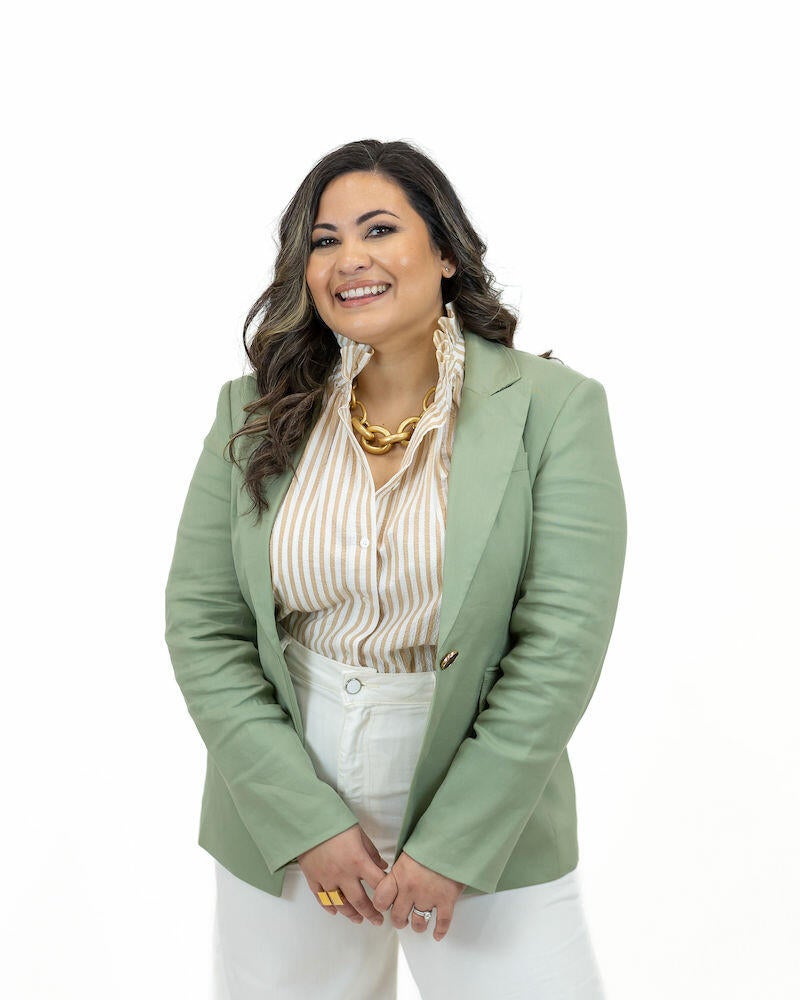As her team swelled to 30 employees, Juliana Oliveira knew something wasn’t right. In pursuit of working smarter, not just more, she streamlined her Dallas firm’s workflow, downsized her team and pushed herself to get picky about the work they took on—what she calls a “strategic realignment” in an effort to reframe her vision for growth.
After scaling up, you had a moment when it felt like the size of your team was actually holding the firm back. What happened?
I’ve always had that ambition of growing a big firm. We got to the point where we had 30 employees turning out 27 projects a year, and we got our own space in a high-rise. In the past year and a half, the growth the business experienced was exponential, to the point that everybody was feeling like they weren’t getting the love and attention they needed—and where it no longer felt like the kind of work-life balance I wanted for the team or for myself. I made the conscious decision to stabilize our workload, make sure that everybody feels supported and figure out how many people we really need on the team to manage the business that’s coming in.

That kind of reflection can be gut-wrenching. Where did you land?
Some people left, and I had to let some people go. We now have 16 full-time team members, plus a few part-time people, and at first, I was hesitant, like, “Are we going to be able to do what we normally do with so few people?” But I’ve been taking it day by day, and it’s totally manageable.
Beyond the size of the team, what else changed?
With fewer team members, I knew we had to take some of the workload off our plate, which could mean losing revenue. I try not to make decisions based on fear. If my gut is telling me something, I want to make sure that I hear it—even if logically I’m like, “That could be bad.” And I’m so glad that I listened because it was the ticket. I’m saying no to a lot of projects now. It’s scary to do that when you can see all those opportunities [you’re not taking], but this year has been our most successful out of the past five years.
I’m always walking that fine line of looking at our workload and asking myself, Do we need to hire another designer? Do we need to hire another project manager? But whenever I check in with the team, I’m surprised to discover that everybody feels OK. I’m having more conversations with people individually now because I get to work with them one-on-one more.
How did having more one-on-one time with each of your employees change your perspective?
When we had 30 employees, we had more middle-management positions, which were director roles. We divided the team into four departments, which helped us stay organized and be very specialized in what each person does. This entire process started because our director of production—who was overseeing our lead designers, unit designer, project managers and anybody working with production of the design and implementation of projects—started to get a little burned out. She’s the person on my team who has been with me the longest. I saw her struggling and I offered to step back into that role to give her a break.
As I started meeting with the designers and project managers more frequently, I found that they really missed having that one-on-one time with me, and that it made them feel more stable and confident. That’s what sparked my curiosity. Obviously I’m just one person—I can’t spread myself across 30 people. But I started thinking, “What would it take to make sure that the team is strong and they all feel secure, so that they’re not looking for another position where they feel more supported?” That’s when I made the decision to scale back.
That time with team members has also allowed me to see gaps in our process in real time. It’s one thing to turn out a lot of projects and bring in a lot of revenue; it’s another to be lean and profitable, and to run a really tight ship. I knew there was room for more efficiency, but it’s been surprising to see just how many little tweaks we’ve been able to make—and the result wasn’t just profitability or running a leaner company; it was also better quality of life for our employees. If they’re doing things more efficiently, they all have a little bit more time. It eliminated a lot of pressure and some of those late nights at work. I didn’t anticipate that result, but it has been a very nice surprise.
What were some of the time sinks you were able to eliminate?
We had lots of meetings. When you have that many people, there’s got to be a day to debrief. But as my business coach told me, meetings are time vampires. I knew I didn’t want to be the person going from meeting to meeting, but there was no way to eliminate that and not have everything else fall apart. As a boss, you think having more meetings is better because you want the information and communication. I started seeing stories about Fortune 500 companies using 15-minute meetings [where you have a focused agenda, send more information to attendees in advance and limit the scope of discussion] and I’ve started to implement that thinking in our business, even if it’s just scaling back one-hour meeting blocks to 30 minutes. As designers, we tend to think of ourselves as little businesses, but we’re real businesses, and we need to make sure that we’re benefiting from the information coming out of larger businesses.

What were some of the other good things about having a smaller team?
I didn’t know how long I was going to be happy after scaling back. Was I going to get bored? Were we not going to get as much business? And the complete opposite has happened: Our revenue is the same, but we’re running with 16 people and we have fewer projects—but better projects. Saying no to so many projects has really opened up better opportunities for us. I’d heard that all the time from other designers, but now I’ve gotten to see and experience it.
Who really believes that when you hear it? It’s like, “That’s nice—I’m so glad saying no worked for you, but I’m just trying to survive over here.”
I was a skeptic too, which is why I was saying yes to everything. I think that’s also just in our nature as designers: We see a challenge and we want to take it. You think, “Oh, it’s going to be easy” because you know what the solution is. But with some self-reflection, I came to realize that the projects we had issues with were the smaller ones that didn’t have the budget.
It takes so much more time and effort to manage projects that we’re not as aligned with. But because we had the bandwidth, I always thought, “Hey, it’s an opportunity for another project. Who knows? This may be great.” When I first started saying no, I was like, “What happens tomorrow? What if we don’t get another project for three months?” But we have not skipped a beat.
How has this process changed your idea of how the firm should evolve? Is downsizing a permanent shift for you, or do you still imagine the firm growing back into a larger operation in the future?
My goal was to take 2023 to scale back. In my mind, I thought that meant scaling back in all areas. I didn’t realize that we would be doing as much volume as we were, just with fewer people. Now I know we can do half the projects we’ve done before if we just increase the size of the projects—we’re doing the same volume as before, just with more focused work, which I’ve found more rewarding. When you’re working with fewer clients, it’s much easier to manage personalities.
But I do want to grow again. I’ve always had that aspiration for a bigger firm, and as we went through that growth, I really enjoyed it. What I’ve learned is that if we are going to do that, it’s not a race. We have to do it brick by brick, and just because opportunities keep presenting themselves doesn’t mean those are the opportunities for you at that time. I’ve also learned how important it is to get team members the support they need from the beginning so that those roots are grounded within the values of your company. It takes a lot of effort to train people, but if we take that additional time in the beginning, that’s a better foundation for growth.
How do you plan to preserve and protect all that but still allow your business to expand?
It’s growing slower so that I can spend the time necessary to [develop] the people who work for me and give them the support to the point that they feel empowered to make decisions on their own. We’ve always had an orientation period—for the first three to five days, you’re in orientation for three hours a day with our HR person and then we partner you with somebody on the team. But if I’m partnering this new person with somebody who didn’t spend time with me and doesn’t feel 100 percent [confident] either, then I’m just duplicating the problem. Once they live and breathe our values, they can pass those on to the people they are training.
Homepage image: A textured wallcovering grounds a soothing primary bedroom | Matti Gresham




































